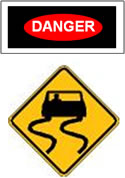 A warning must inform individuals of a danger, which would not be obvious to them. It must tell them how to avoid the danger, and be easily understood. It should also provide them with the consequences of not heading the warning. In order to achieve these objectives, the warning should be well visible and capture attention. Thus, it should be placed where individuals may be expected to see it during the normal course of their activity. Hence, it is better to place a warning at a potentially dangerous location, which confronts the user constantly, rather than where it will only be encountered occasionally.
A warning must inform individuals of a danger, which would not be obvious to them. It must tell them how to avoid the danger, and be easily understood. It should also provide them with the consequences of not heading the warning. In order to achieve these objectives, the warning should be well visible and capture attention. Thus, it should be placed where individuals may be expected to see it during the normal course of their activity. Hence, it is better to place a warning at a potentially dangerous location, which confronts the user constantly, rather than where it will only be encountered occasionally.
Expertise
We have developed warnings for industrial machinery and consumer products. We have also served as warnings experts in various litigation matters. We possess:
- Membership in the Human Factors and Ergonomics Society which promotes warnings research
- An extensive warnings library including relevant standards
Questions Answered
Through scientific analysis, we can help you answer pertinent questions such as:
- Was the warning properly placed?
- Was the wording or pictorial unambiguous?
- Did it instruct what action to take or not take?
- Were the consequences of heeding or not heeding the warning clear?
Case Examples
Worker Finger Amputation:
A worker operating a packaging machine suffered finger amputation when he inserted his hand into an exit chute on the machine. We showed that a knife guard would interfere with the operation of the machine and so had developed a warning sign for the exit chute explicitly stating "DANGER - Hidden Knife. Do NOT insert hand", boldly featuring a pictorial showing a hand being cut. The machine's maker prevailed.
Commercial Stove Fire:
An exhaust-duct cooking-grease fire burned uncontrollably because the fire suppression system was not activated. Acting as Plaintiff's expert, we were able to show how simple warnings would have alerted the kitchen staff regarding where the pull-chain for the fire suppression system was located and when and how to simply use it. This resulted in a significant award for the restaurant as compensation for the fire's devastating effects.
Kristopher J. Seluga, PE, is a Mechanical Engineering, Accident Reconstruction, Biomechanics, and Safety Expert with over 20 years of experience. He received his Bachelor's and Master's degrees from the Mechanical Engineering department at MIT where he worked on the development of novel three-dimensional printing technologies. Mr. Seluga is also a licensed Professional Engineer in New York and Connecticut, and has served as a member of the ANSI engineering committee for the Z130.1 and Z135 standards for golf cars and PTV's. His research interests and peer reviewed publications span the topics of Motor Vehicle Dynamics, Product Safety, and Biomechanics.
©Copyright - All Rights Reserved
DO NOT REPRODUCE WITHOUT WRITTEN PERMISSION BY AUTHOR.



 A warning must inform individuals of a danger, which would not be obvious to them. It must tell them how to avoid the danger, and be easily understood. It should also provide them with the consequences of not heading the warning. In order to achieve these objectives, the warning should be well visible and capture attention. Thus, it should be placed where individuals may be expected to see it during the normal course of their activity. Hence, it is better to place a warning at a potentially dangerous location, which confronts the user constantly, rather than where it will only be encountered occasionally.
A warning must inform individuals of a danger, which would not be obvious to them. It must tell them how to avoid the danger, and be easily understood. It should also provide them with the consequences of not heading the warning. In order to achieve these objectives, the warning should be well visible and capture attention. Thus, it should be placed where individuals may be expected to see it during the normal course of their activity. Hence, it is better to place a warning at a potentially dangerous location, which confronts the user constantly, rather than where it will only be encountered occasionally.





